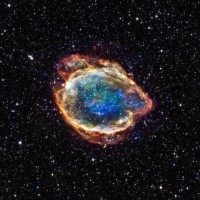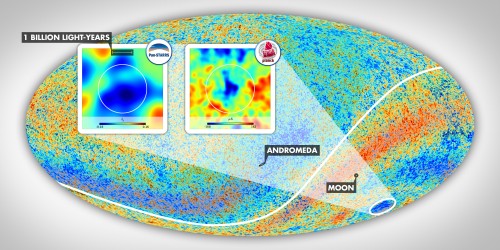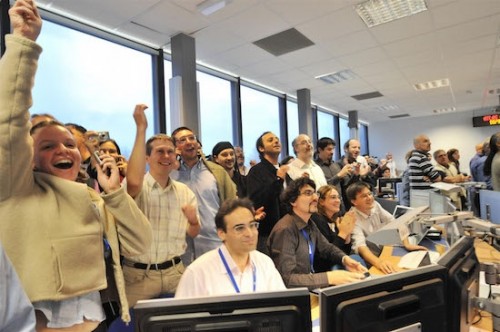Tag archives: cosmology
Einstein’s legacy, 100 years on
By Tushna Commissariat
As readers of Physics World, you probably don’t need me to tell you that this year marks 100 years since legendary physicist Albert Einstein laid the foundations for his revolutionary general theory of relativity (GR). This month marks the exact time when he began giving a series of four weekly lectures – the first of which was on 4 November 1915 – to the Prussian Academy of Sciences in Berlin. Indeed, today is the centenary of the final lecture, when he presented his “Field equations of gravitation”. In the video above, philosopher and one-time physicist Jürgen Renn, from the Max Planck Institute for the History of Science in Berlin, gives a short and sweet explanation of GR and its impact on physics.
Is dark energy becoming marginalized?
By Tushna Commissariat

Supernovae secrets: Chandra image of G299, a type Ia supernova remnant. (Courtesy: NASA/CXC/U Texas)
Here at Physics World, we enjoy a good debate and late last week, a paper appeared on the arXiv server that is bound to kick up quite the storm, once it has been peer-reviewed and published. Titled “Marginal evidence for cosmic acceleration from type Ia supernovae”, the paper was written by Subir Sarkar of the Particle Theory Group at the University of Oxford and the Niels Bohr Institute in Copenhagen, together with colleagues Alberto Guffanti and Jeppe Trøst Nielsen. It suggests that the cosmic expansion may not be occurring at an accelerating rate after all, contrary to the findings of previous Nobel prize-winning work and most of our current standard cosmological models, including that of dark energy.
Indeed, the researchers’ work suggests that the evidence for acceleration is nowhere near as strong as previously suggested – it is closer to 3σ rather than 5σ, and allows for expansion at a constant velocity. Nielsen et al. have come to this conclusion after studying a much larger database of type Ia supernovae – 50 of which were studied in the original work, while this study looks at 740 – that are used as “standard candles” to detect cosmic acceleration.
This study is sure to make many cosmologists sit up and take notice, and an interesting discussion is sure to follow. So watch this space and check back in with us, once the paper is published and we catch up with Sarkar and his colleagues.
Hawking on 1D, Chernobyl fires, psychedelic science and more
By Tushna Commissariat
It’s not often that physics, or indeed a physicist, has much in common with pop music or exceedingly popular boy bands. But earlier this week, at an event at the Sydney Opera House titled “An Evening with Stephen Hawking, with Lucy Hawking and Paul Davies”, an audience member asked Hawking (who appeared in holographic form) “What do you think is the cosmological effect of Zayn Malik leaving One Direction?” Watch the video above to see what Hawking said to comfort the distraught fan and how theoretical physics truly may have all the answers.
The May 2015 issue of Physics World is now out
By Matin Durrani
A couple of years back, I had the pleasure of travelling 1100 metres below ground to visit a dark-matter laboratory at the bottom of the Boulby Mine on the north-east coast of England. The journey was certainly memorable – it involved plunging down in a rattling lift cage for several minutes with a group of miners setting off on their morning shift. Once in the lab – housed inside a souped-up set of trailers – I interviewed physicist Sean Paling about the experimental projects going on there.
Setting up an underground lab, like that at Boulby, certainly doesn’t come cheap and in recent years, many have started to diversify into new areas. In the May issue of Physics World, which is now out in print and digital formats, Paling and his colleague Stephen Sadler – who is director at DURRIDGE UK Radon Instrumentation – describe the renaissance in the science taking place far beneath our feet. Studies in underground labs now range from Mars rovers to muon tomography and from radioactive dating to astrobiology.
Astronomers fill supervoid in their knowledge

The cold spot (bottom right) resides in the southern galactic hemisphere. (Courtesy: ESA Planck collaboration)
By James Dacey
Astronomers believe they may finally be able to explain the origin of the “cold spot”, a glaringly large cool region in the cosmic microwave background (CMB). Maps of the CMB, such as that created by the Wilkinson Microwave Anisotropy Probe (WMAP) and more recently by the Planck mission, reveal the distribution of radiation left over after the Big Bang. When in 2004 researchers noticed this cold spot on the map, they soon realized it was either a sign of exotic physics linked to the Big Bang itself or it was caused by some sort of structure in the foreground between the CMB and the Earth.
View all posts by this author | View this author's profile
Pioneering women of physics, why you should become a particle physicist and a BICEP2 scientist on all that dust

Smiley happy people: who would not want to be a particle physicist? (Courtesy: ATLAS)
By Hamish Johnston
Over on the Quantum Diaries blog, Aidan Randle-Conde has put together a lovely photo-essay called “30 reasons why you shouldn’t be a particle physicist”. It is reverse psychology, of course, and the 30 images highlight the benefits of devoting your life to studying sub-atomic particles. As someone who chose to do condensed-matter physics, do I now think that I made a huge mistake? No, but I have shared the thrill and excitement of being at CERN when the Higg’s was discovered and seen the Large Hadron Collider and its detectors up close, so I know where he is coming from.
View all posts by this author | View this author's profile
Space bonanza to land in Manchester

The Age of Starlight will catch both the eyes and the minds of the audience. (Courtesy: ESO/P D Barthel)
By James Dacey
Whatever punters make of the Manchester International Festival (MIF) next year, they certainly won’t be able to accuse it of thinking small. Among the first commissions announced today is a “world-first show about the origin of the universe and everything within and without it”.
The Age of Starlight will be presented by the physicist and TV personality Brian Cox, who will tell the story of the unlikely events that have led to our existence. Details of the show are still scarce but we do know that the space bonanza will feature computer-generated imagery created by the Oscar-winner Tim Webber and the special-effects team behind the film Gravity. The event will be brought to life with technologies developed by Magic Leap, a Florida-based IT company that specializes in “magical” computing solutions.
View all posts by this author | View this author's profile
A look back at how the dust fell on BICEP2
By Tushna Commissariat
It’s been five days since the metaphorical dust settled on the apparent “discovery” of the B-mode polarization of the cosmic microwave background that was reported in March. The claim came from the team behind the Background Imaging of Cosmic Extragalactic Polarization (BICEP2) telescope at the South Pole, and much has been said since about what was then hailed as one of the biggest scientific discoveries of the decade.
View all posts by this author | View this author's profile
Extra dimensions, other-worldly football, the ISS at night and more
By Tushna Commissariat
This week, we came across the above video on “extra dimensions”, in which physicist Don Lincoln talks about the possible physical reality of such dimensions and why we need them. The video begins with Lincoln pointing out just how weak a force gravity is, especially when compared with, say, magnetism. He then goes on to talk about how gravity may exist in more than the three dimensions we experience, making sure to point out that these “extra dimensions” are not of the Hollywood variety in which a different reality may exist. This video is part of Fermilab’s “Big Mysteries” video series – be sure to take a look at the rest.
Particle man meets universe man
By Margaret Harris
When particle physicist Jon Butterworth and cosmologist Pedro Ferreira took the stage last night at the Bristol Festival of Ideas, they did so as representatives of the two pillars of modern physics. Butterworth, a leading member of the ATLAS collaboration at CERN’s Large Hadron Collider, spoke about the discovery of the Higgs boson and the effort to understand the nature of matter on the quantum level. Ferreira, a theorist at the University of Oxford, focused on Einstein’s general theory of relativity, which describes the behaviour of colossal objects such as galaxies and black holes.
The equations of quantum mechanics and general relativity are famously incompatible, but far from starting a Harry Hill-style confrontation (“FIIIIGHT!”), the advocates of the two theories shared the stage amiably, fielding questions from audience members and talking about their respective new books (Smashing Physics for Butterworth, The Perfect Theory for Ferreira). You can hear Ferreira and Butterworth’s responses to some common (and not-so-common) questions in the clips below.